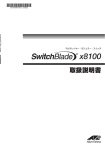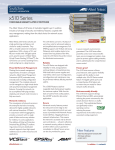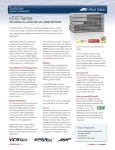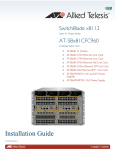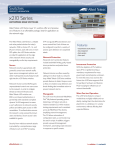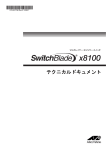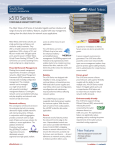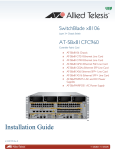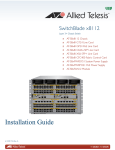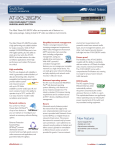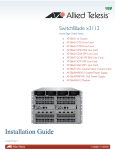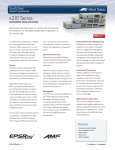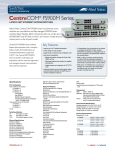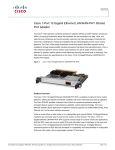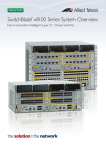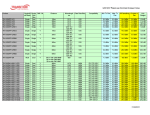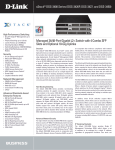Download Allied Telesis AT-SBX8112 network chassis
Transcript
Switches PRODUCT INFORMATION SwitchBlade x8100 Series ® WITH CFC400 CONTROLLER Next generation intelligent Layer 3+ chassis switches The Allied Telesis SwitchBlade x8100 Series of advanced Layer 3+ chassis switches are available in 6 and 12 slot models. The CFC400 based system delivers high availability, wirespeed performance, and a high port count. Advanced features provide the ideal solution for the modern enterprise network, where resiliency, reliability and high performance are the key requirements. SwitchBlade x8100 Series switches provide a high performing scalable solution, with an extensive range of connectivity options. Dual CFC400 control cards provide resiliency. Gigabit and 10 Gigabit line card options ensure a system capable of meeting the requirements of today’s networks, and the flexibility to expand when required. High performing Dual CFC400 control cards provide 80Gbps non-blocking throughput to each line card slot, providing maximum performance and wirespeed delivery of critical IPv4 and IPv6 traffic. Enjoy effortless maximum availability of premium services and applications, with industry-leading Quality of Service (QoS) features managing network responsiveness. over Ethernet (PoE) PSUs maximizes power available to connected devices. The active/active control cards interconnect through redundant paths to the line cards over a passive backplane. Control cards, line cards, power supplies and fan tray are all hot-swappable, to minimize downtime when performing maintenance or upgrading the system. To provide a high-speed solution where recovery occurs within as little as 50ms, SwitchBlade x8100 Series switches can be deployed in a ring-based topology, with the protected ring running at up to 10Gbps. This high performing resilient design for distributed networks is made possible with Allied Telesis EPSRing™ (Ethernet Protection Switched Ring) technology. Powerful network management Scalable The Allied Telesis Management Framework (AMF) meets the increased management requirements of modern converged networks, automating many everyday tasks including configuration management. AMF has powerful centralized management features that manage a complete network as a single virtual device. The network can be expanded with plug-and-play simplicity, and network node recovery is fully zerotouch. The choice of 6 and 12-slot chassis versions provides a powerful solution for networks of all sizes, and both versions share the same fully featured AlliedWare Plus™ Operating System. Resilient There are currently three 24-port Gigabit line cards available: copper, PoE+ and fiber (SFP). SwitchBlade x8100 Series switches operate with one AC or DC system PSU. Installing a second load-sharing PSU provides ultimate redundancy. Installing two Power alliedtelesis.com To expand the SwitchBlade x8100 system to encompass large networks, including stacking two chassis with VCStack Plus™, the CFC400 control cards can be replaced with CFC960 control cards. The 40-port Gigabit copper line card maximizes port density, providing up to 400 Gigabit copper ports in a single 7RU SwitchBlade x8112 chassis, or 200 Gigabit copper ports in a single 4RU SwitchBlade x8106 chassis. The 6-port 10 Gigabit (SFP+) line card provides the SwitchBlade x8100 Series with high-speed backbone connectivity. Power over Ethernet Plus (PoE+) SwitchBlade x8100 Series switches support IEEE 802.3at PoE+ (30W) allowing you to future-proof your network. The greater power supplied by PoE+ supports applications such as pan, tilt and zoom IP surveillance cameras, IP video phones, and wireless access points. Environmentally friendly SwitchBlade x8100 Series switches are designed to reduce power consumption and minimize hazardous waste. Features include high efficiency power supplies and low power chip sets. An ECOSwitch button on the front panel allows additional power conservation, by turning off all diagnostic LED indicators when they are not required. New features »»Allied Telesis Management Framework (AMF) enhancements for networks up to 80 nodes »»BGP4+ for IPv6 SwitchBlade x8100 Series (SBx81CFC400) | Intelligent Layer 3+ Chassis Switches Key Features Allied Telesis Management Framework (AMF) Power over Ethernet Plus (PoE+) sFlow »»Allied Telesis Management Framework (AMF) is a sophisticated suite of management tools that provide a simplified approach to network management. Common tasks are automated, or made so simple that you can achieve the everyday running of a network without the need for highly trained network engineers. Powerful features like centralized management, auto-backup, auto-upgrade, auto-provisioning and auto-recovery enable plug-andplay networking and zero-touch management. »»Any SwitchBlade x8100 Series switch can operate as the AMF network master, storing firmware and configuration backups for all other network nodes. The AMF master enables auto-provisioning and auto-upgrade by providing appropriate files to new network members. »»The CFC400 can manage AMF networks of up to 80 nodes, which can be located locally or across WAN links. »»With PoE, a separate power connection to media end points such as IP phones and wireless access points is not necessary. PoE+ provides even greater flexibility, providing the capability to connect devices requiring more power (up to 30 Watts)—for example, tilt and zoom security cameras. »»sFlow is an industry standard technology for monitoring high-speed switched networks. It gives complete visibility into network use, enabling performance optimization, usage accounting/billing, and defence against security threats. Sampled packets sent to a collector ensure it always has a real-time view of network traffic. Ease of management »»The AlliedWare Plus operating system incorporates an industry standard CLI, facilitating intuitive manageability. »»You can automate configuration tasks since commands may be used in scripts. Triggers can also be utilized. These provide a powerful mechanism for automatic and timed management, by automating command execution in response to specific events. »»With three distinct user modes, the CLI is very secure, and the use of encrypted remote login sessions ensures CLI access is not compromised. EPSRing™ (Ethernet Protection Switched Ring) »»EPSRing and 10 Gigabit Ethernet allow several switches to form a high-speed protected ring capable of recovery within as little as 50ms. This feature is perfect for high performance and high availability at the core of enterprise or provider access networks. »»Superloop Protection enables a link between two EPSR nodes to be in separate EPSR domains, improving redundancy and network fault resiliency. Access Control Lists (ACLs) »»AlliedWare Plus™ delivers industry-standard access control functionality with ACLs. ACLs filter network traffic to control whether routed packets are forwarded or blocked at the port interface. This provides a powerful network security mechanism to select the types of traffic to be analyzed, forwarded, or otherwise influenced. Industry-leading Quality of Service (QoS) »»Comprehensive low-latency wirespeed QoS provides flow-based traffic management with full classification, prioritization, traffic shaping and min/max bandwidth profiles. Enjoy boosted network performance and guaranteed delivery of business-critical Ethernet services and applications. Time-critical services such as voice and video take precedence over nonessential services such as file downloads, maintaining responsiveness of enterprise applications. 2 | SwitchBlade x8100 Series with CFC400 AlliedWare Plus licensing unlocks new features »»With AlliedWare Plus, a single license password is all that is necessary to unlock additional feature bundles that ship with the switch. The feature bundles provide a very simple upgrade path. Dynamic Host Configuration Protocol (DHCPv6) »»DHCPv6 is used to dynamically assign IPv6 addresses to hosts from a central location. Acting as DHCPv6 client enables the switch to receive an IPv6 address, and acting as server enables the switch to dynamically allocate IPv6 addresses to hosts. The DHCPv6 server and client both support the Prefix Delegation feature which allocates a whole IPv6 subnet to a DHCP client. The client, in turn, can allocate addresses from this subnet to the hosts that are connected to it. Virtual Router Redundancy Protocol (VRRPv3) »»VRRPv3 is a protocol for providing device redundancy, by connecting redundant WAN gateway routers or server access switches in an IPv6 network. It allows a backup router or switch to automatically take over if the primary (master) router or switch fails. Network Access Control (NAC) »»NAC allows for unprecedented control over user access to the network in order to mitigate threats to network infrastructure. Allied Telesis SwitchBlade x8100 Series switches use IEEE 802.1x port-based authentication in partnership with standardscompliant dynamic VLAN assignment, to assess a user’s adherence to network security policies and either grant access or offer remediation. »»If multiple users share a port, multi-authentication can be used. Different users on the same port can be assigned into different VLANs, and so given different levels of network access. Additionally, a Guest VLAN can be configured to provide a catch-all for users who aren’t authenticated. Tri-authentication »»Authentication options on SwitchBlade x8100 switches also include alternatives to IEEE 802.1x port-based authentication, such as Web authentication to enable guest access, and MAC authentication for end points that do not have an IEEE 802.1x supplicant. All three authentication methods—IEEE 802.1x, MAC-based and Web-based—can be enabled simultaneously on the same port. This is called tri-authentication. Link aggregation »»Link aggregation allows a number of individual switch ports to be combined, forming a single logical connection of higher bandwidth. This provides a higher performance link, and redundancy for a reliable and robust network. The SwitchBlade x8100 Series allow link aggregation groups to be created across line cards to maximize link resiliency. Hardware performance »»Layer-3 switching and routing is performed in specialized ASIC hardware for wirespeed packet forwarding and maximum throughput. SwitchBlade x8100 Series (SBx81CFC400) | Intelligent Layer 3+ Chassis Switches Key Solutions 10 x2 Network core resiliency The convergence of network services in the enterprise has led to increasing demand for high performing networks with minimal downtime. In this solution, a SwitchBlade x8112 with dual CFC400 control cards provides a powerful network core with extremely high reliability. PSU redundancy ensures maximum uptime, while hot-swappable PSUs, fan tray, control and line cards allow for system maintenance or reconfiguration with no network interruption. 10 x2 4 10 0-2 x5 x60 10 x2 Real-time applications like VoIP and streaming video are assured premium service on the network, as near hitless failover between the dual control cards on the SwitchBlade x8112 means there is no perceptible disruption in the case of a problem. 10 x2 4 10 0-2 x5 x60 Link aggregation across line cards to servers, network storage, and distribution switches leaves no single point of failure in this high performing network core. Network Attached Storage 2 11 x8 SB Server Farm 10 x2 er ut Ro 10 Gigabit link 1 Gigabit link 10/100 link Link aggregation Internet SwitchBlade x8100 Series with CFC400 | 3 SwitchBlade x8100 Series (SBx81CFC400) | Intelligent Layer 3+ Chassis Switches Key Solutions Distributed network with EPSRing Wherever a distributed network design is required, Allied Telesis Ethernet Protection Switched Ring (EPSRing) with the SwitchBlade x8106 is ideal, providing high-speed 10GbE connectivity. Failover in a little as 50ms prevents a node or link failure from affecting customer experience, even when using demanding applications such as IP telephony and video monitoring. This is the ideal solution for ensuring continual access to online resources and applications in a multi-building business. Now that technology has made high-availability and high-bandwidth so accessible, corporate business, education providers and other enterprise network users can enjoy the many benefits that EPSRing provides. This advanced self-healing network technology meets today's constant demand for information. 10 x6 10 x6 10 x6 6 6 10 x8 SB 810 SBx 10 x5 6 10 x8 SB Servers 10 Gigabit link 1 Gigabit link 10/100 link Link aggregation 4 | SwitchBlade x8100 Series with CFC400 SwitchBlade x8100 Series (SBx81CFC400) | Intelligent Layer 3+ Chassis Switches Product Specifications AT-SBx81CFC400 (Controller Fabric Card) »»512MB SDRAM »»512KB NVRAM »»128MB flash memory »»Up to 32K MAC addresses* »»Up to 16K IP routes maximum* »»24Mbit packet buffer memory »»Supports 10KB jumbo packets »»4K VLANs AT-SBx81GP24 (24 x 10/100/1000T PoE+ line card) »»12Mbit packet buffer memory AT-SBx81GT24 (24 x 10/100/1000T line card) »»12Mbit packet buffer memory AT-SBx81GT40 (40 x 10/100/1000T RJ.5 line card) »»32Mbit packet buffer memory AT-SBx81GS24a (24 x 100/1000 SFP line card) »»24Mbit packet buffer memory AT-SBx81XS6 (6 x 10Gbps SFP+ line card) »»24Mbit packet buffer memory Reliability »»Modular AlliedWare Plus operating system »»Redundant controller fabric cards »»Redundant 1200W AC or DC system power supplies »»Load-sharing 1200W PoE+ power supplies »»Full environmental monitoring of PSUs, fans, temperature and internal voltages. SNMP traps alert network managers in case of failure »»Route maps and route redistribution (OSPF, BGP, RIP) »»Static unicast and multicast routes for IPv4 »»UDP broadcast helper (IP helper) »»Loop protection: loop detection and thrash limiting »»PVST+ compatibility mode »»STP root guard IPv6 features Security features »»DHCPv6 relay, DHCPv6 client »»DNSv6 relay, DNSv6 client »»IPv4 and IPv6 dual stack »»IPv6 QoS and hardware ACLs »»Device management over IPv6 networks with SNMPv6, Telnetv6, SSHv6 and Syslogv6 »»NTPv6 client and server »»Static unicast and multicast routes for IPv6 »»Access Control Lists (ACLs) based on layer 3 and 4 headers »»Configurable auth-fail and guest VLANs »»Authentication, Authorisation and Accounting (AAA) »»Bootloader can be password protected for device security »»BPDU protection »»DHCP snooping, IP source guard and Dynamic ARP Inspection (DAI) »»Dynamic VLAN assignment »»MAC address filtering and MAC address lock-down »»Network Access and Control (NAC) features manage endpoint security »»Port-based learn limits (intrusion detection) »»Private VLANs provide security and port isolation for multiple customers using the same VLAN »»Secure Copy (SCP) »»Strong password security and encryption »»Tri-authentication: MAC-based, web-based and IEEE 802.1x Management »»Allied Telesis Management Framework (AMF) enables powerful centralized management and zero-touch device installation and recovery »»Eco-friendly mode allows ports and LEDs to be disabled to save power »»Web-based Graphical User Interface (GUI) »»Industry-standard CLI with context-sensitive help »»Out-of-band 10/100/1000T Ethernet management port on the CFC front panel for ease of access »»Powerful CLI scripting engine and built-in text editor »»Comprehensive SNMP MIB support for standardsbased device management »»Management via Telnet or SSH to CLI, or HTTP to web interface (GUI) »»Event-based triggers allow user-defined scripts to be executed upon selected system events »»USB interface allows software release files, configurations and other files to be stored for backup and distribution to other devices Quality of Service (QoS) Expandability »»High-speed line slots support any mix of hotswappable cards for port flexibility and application versatility »»Premium license option for additional features »»AMF Master license option Flexibility and compatibility »»Gigabit SFP ports will support any combination of 1000T, 100FX, 100BX, 1000SX, 1000LX, 1000ZX or 1000ZX CWDM SFPs »»10G SFP+ ports will support any combination of 10GSR, 10GLR or 10GER SFP+ modules and SFP+ direct attach cables Diagnostic tools »»Hardware health monitoring »»Automatic link flap detection and port shutdown »»Optical Digital Diagnostic Monitoring (DDM) »»Ping polling and TraceRoute for IPv4 and IPv6 »»Port mirroring IPv4 features »»Black hole routing »»Directed broadcast forwarding »»DNS relay »»Equal Cost Multi Path (ECMP) routing »»8 priority queues with a hierarchy of high priority queues for real time traffic, and mixed scheduling, for each switch port »»Limit bandwidth per port or per traffic class down to 64kbps »»Wirespeed traffic classification with low latency essential for VoIP and real-time streaming media applications »»Policy-based QoS based on VLAN, port, MAC and general packet classifiers »»Policy-based storm protection »»Taildrop for queue congestion control »»Strict priority, weighted round robin or mixed scheduling »»IP precedence and DiffServ marking based on layer 2, 3 and 4 headers »»DSCP remarking based on TCP/UDP port number Resiliency features »»Control Plane Prioritization (CPP) ensures the CPU always has sufficient bandwidth to process network control traffic »»Dynamic link failover (host attach) »»EPSRing (Ethernet Protection Switched Rings) with SuperLoop Protection (SLP) »»EPSR enhanced recovery for extra resiliency Environmental specifications »»Operating temperature range: 0°C to 40°C (32°F to 104°F). Derated by 1°C per 305 meters (1,000 ft) »»Storage temperature range: -25°C to 70°C (-13°F to 158°F) »»Operating relative humidity range: 5% to 90% non-condensing »»Storage relative humidity range: 5% to 95% non-condensing »»Operating altitude: 3,048 meters maximum (10,000 ft) Electrical approvals and compliances »»EMC: EN55022 class A, FCC class A, VCCI class A »»Immunity: EN55024, EN61000-3-levels 2 (Harmonics), and 3 (Flicker) – AC models only Safety »»Standards: UL60950-1, CAN/CSA-C22.2 No. 60950-1-03, EN60950-1, EN60825-1, AS/NZS 60950.1 »»Certification: UL, cUL, TUV Restrictions on Hazardous Substances (RoHS) compliance »»EU RoHS compliant »»China RoHS compilant Country of origin »»Singapore * Depending on selected configuration SwitchBlade x8100 Series with CFC400 | 5 SwitchBlade x8100 Series (SBx81CFC400) | Intelligent Layer 3+ Chassis Switches Standards and Protocols AlliedWare Plus Operating System Version 5.4.4 Authentication RFC 1321 MD5 Message-Digest algorithm RFC 1828 IP authentication using keyed MD5 Border Gateway Protocol (BGP) BGP dynamic capability BGP outbound route filtering RFC 1772 Application of the Border Gateway Protocol (BGP) in the Internet RFC 1997 BGP communities attribute RFC 2385 Protection of BGP sessions via the TCP MD5 signature option RFC 2439 BGP route flap damping RFC 2545 Use of BGP-4 multiprotocol extensions for IPv6 inter-domain routing RFC 2858 Multiprotocol extensions for BGP-4 RFC 2918 Route refresh capability for BGP-4 RFC 3392 Capabilities advertisement with BGP-4 RFC 3882 Configuring BGP to block Denial-of-Service (DoS) attacks RFC 4271 Border Gateway Protocol 4 (BGP-4) RFC 4360 BGP extended communities RFC 4456 BGP route reflection - an alternative to full mesh iBGP RFC 4724 BGP graceful restart RFC 4893 BGP support for four-octet AS number space RFC 5065 Autonomous system confederations for BGP Encryption FIPS 180-1 Secure Hash standard (SHA-1) FIPS 186 Digital signature standard (RSA) FIPS 46-3 Data Encryption Standard (DES and 3DES) Ethernet IEEE 802.1AXLink aggregation (static and LACP) IEEE 802.2 Logical Link Control (LLC) IEEE 802.3 Ethernet IEEE 802.3ab1000BASE-T IEEE 802.3adStatic and dynamic link aggregation IEEE 802.3ae10 Gigabit Ethernet IEEE 802.3af Power over Ethernet (PoE) IEEE 802.3at Power over Ethernet plus (PoE+) IEEE 802.3azEnergy Efficient Ethernet (EEE) IEEE 802.3u 100BASE-X IEEE 802.3x Flow control - full-duplex operation IEEE 802.3z 1000BASE-X IPv4 features RFC 768 User Datagram Protocol (UDP) RFC 791 Internet Protocol (IP) RFC 792 Internet Control Message Protocol (ICMP) RFC 793 Transmission Control Protocol (TCP) RFC 826 Address Resolution Protocol (ARP) RFC 894 Standard for the transmission of IP datagrams over Ethernet networks RFC 919 Broadcasting Internet datagrams RFC 922 Broadcasting Internet datagrams in the presence of subnets RFC 932 Subnetwork addressing scheme RFC 950 Internet standard subnetting procedure RFC 951 Bootstrap Protocol (BootP) RFC 1027 Proxy ARP RFC 1035 DNS client RFC 1042 Standard for the transmission of IP datagrams over IEEE 802 networks RFC 1071 Computing the Internet checksum RFC 1122 Internet host requirements RFC 1191 Path MTU discovery RFC 1256 ICMP router discovery messages RFC 1518 An architecture for IP address allocation with CIDR RFC 1519 Classless Inter-Domain Routing (CIDR) RFC 1542 Clarifications and extensions for BootP 6 | SwitchBlade x8100 Series with CFC400 RFC 1591 Domain Name System (DNS) RFC 1812 Requirements for IPv4 routers RFC 1918 IP addressing RFC 2581 TCP congestion control IPv6 features RFC 1981 Path MTU discovery for IPv6 RFC 2460 IPv6 specification RFC 2464 Transmission of IPv6 packets over Ethernet networks RFC 3056 Connection of IPv6 domains via IPv4 clouds RFC 3484 Default address selection for IPv6 RFC 3596 DNS extensions to support IPv6 RFC 4007 IPv6 scoped address architecture RFC 4193 Unique local IPv6 unicast addresses RFC 4291 IPv6 addressing architecture RFC 4443 Internet Control Message Protocol (ICMPv6) RFC 4861 Neighbor discovery for IPv6 RFC 4862 IPv6 Stateless Address Auto-Configuration (SLAAC) RFC 5014 IPv6 socket API for source address selection RFC 5095 Deprecation of type 0 routing headers in IPv6 RFC 5175 IPv6 Router Advertisement (RA) flags option RFC 6105 IPv6 Router Advertisement (RA) guard Management AMF MIB and SNMP traps AT Enterprise MIB SNMPv1, v2c and v3 IEEE 802.1ABLink Layer Discovery Protocol (LLDP) RFC 1155 Structure and identification of management information for TCP/IP-based Internets RFC 1157 Simple Network Management Protocol (SNMP) RFC 1212 Concise MIB definitions RFC 1213 MIB for network management of TCP/IP-based Internets: MIB-II RFC 1215 Convention for defining traps for use with the SNMP RFC 1227 SNMP MUX protocol and MIB RFC 1239 Standard MIB RFC 1724 RIPv2 MIB extension RFC 2011 SNMPv2 MIB for IP using SMIv2 RFC 2012 SNMPv2 MIB for TCP using SMIv2 RFC 2013 SNMPv2 MIB for UDP using SMIv2 RFC 2096 IP forwarding table MIB RFC 2578 Structure of Management Information v2 (SMIv2) RFC 2579 Textual conventions for SMIv2 RFC 2580 Conformance statements for SMIv2 RFC 2674 Definitions of managed objects for bridges with traffic classes, multicast filtering and VLAN extensions RFC 2741 Agent extensibility (AgentX) protocol RFC 2787 Definitions of managed objects for VRRP RFC 2819 RMON MIB (groups 1,2,3 and 9) RFC 2863 Interfaces group MIB RFC 3164 Syslog protocol RFC 3176 sFlow: a method for monitoring traffic in switched and routed networks RFC 3411 An architecture for describing SNMP management frameworks RFC 3412 Message processing and dispatching for the SNMP RFC 3413 SNMP applications RFC 3414 User-based Security Model (USM) for SNMPv3 RFC 3415 View-based Access Control Model (VACM) for SNMP RFC 3416 Version 2 of the protocol operations for the SNMP RFC 3417 Transport mappings for the SNMP RFC 3418 MIB for SNMP RFC 3621 Power over Ethernet (PoE) MIB RFC 3635 Definitions of managed objects for the Ethernet- like interface types RFC 3636 IEEE 802.3 MAU MIB RFC 4188 Definitions of managed objects for bridges RFC 4318 Definitions of managed objects for bridges with RSTP RFC 4560 Definitions of managed objects for remote ping, traceroute and lookup operations RFC 6527 Definitions of managed objects for VRRPv3 Multicast support Bootstrap Router (BSR) mechanism for PIM-SM IGMP query solicitation IGMP snooping (v1, v2 and v3) IGMP snooping fast-leave IGMP/MLD multicast forwarding (IGMP/MLD proxy) MLD snooping (v1 and v2) PIM for IPv6 RFC 1112 Host extensions for IP multicasting (IGMPv1) RFC 2236 Internet Group Management Protocol v2 (IGMPv2) RFC 2710 Multicast Listener Discovery (MLD) for IPv6 RFC 2715 Interoperability rules for multicast routing protocols RFC 3376 IGMPv3 RFC 3810 Multicast Listener Discovery v2 (MLDv2) for IPv6 RFC 3973 PIM Dense Mode (DM) RFC 4541 IGMP and MLD snooping switches RFC 4601 Protocol Independent Multicast - Sparse Mode (PIM-SM): protocol specification (revised) RFC 4604 Using IGMPv3 and MLDv2 for source-specific multicast RFC 4607 Source-specific multicast for IP Open Shortest Path First (OSPF) OSPF link-local signaling OSPF MD5 authentication OSPF restart signaling Out-of-band LSDB resync RFC 1245 OSPF protocol analysis RFC 1246 Experience with the OSPF protocol RFC 1370 Applicability statement for OSPF RFC 1765 OSPF database overflow RFC 2328 OSPFv2 RFC 2370 OSPF opaque LSA option RFC 2740 OSPFv3 for IPv6 RFC 3101 OSPF Not-So-Stubby Area (NSSA) option RFC 3509 Alternative implementations of OSPF area border routers RFC 3623 Graceful OSPF restart RFC 3630 Traffic engineering extensions to OSPF RFC 4552 Authentication/confidentiality for OSPFv3 RFC 5329 Traffic engineering extensions to OSPFv3 Quality of Service (QoS) IEEE 802.1p Priority tagging RFC 2211 Specification of the controlled-load network element service RFC 2474 DiffServ precedence for eight queues/port RFC 2475 DiffServ architecture RFC 2597 DiffServ Assured Forwarding (AF) RFC 3246 DiffServ Expedited Forwarding (EF) Resiliency features IEEE 802.1D MAC bridges IEEE 802.1s Multiple Spanning Tree Protocol (MSTP) IEEE 802.1w Rapid Spanning Tree Protocol (RSTP) RFC 5798 Virtual Router Redundancy Protocol version 3 (VRRPv3) for IPv4 and IPv6 Routing Information Protocol (RIP) RFC 1058 Routing Information Protocol (RIP) RFC 2080 RIPng for IPv6 RFC 2081 RIPng protocol applicability statement RFC 2082 RIP-2 MD5 authentication RFC 2453 RIPv2 SwitchBlade x8100 Series (SBx81CFC400) | Intelligent Layer 3+ Chassis Switches Security features SSH remote login SSLv2 and SSLv3 TACACS+ accounting and authentication IEEE 802.1X authentication protocols (TLS, TTLS, PEAP and MD5) IEEE 802.1X multi-supplicant authentication IEEE 802.1X port-based network access control RFC 2246 TLS protocol v1.0 RFC 2865 RADIUS RFC 2866 RADIUS accounting RFC 2868 RADIUS attributes for tunnel protocol support RFC 3546 Transport Layer Security (TLS) extensions RFC 3579 RADIUS support for Extensible Authentication Protocol (EAP) RFC 3580 IEEE 802.1x RADIUS usage guidelines RFC 3748 PPP Extensible Authentication Protocol (EAP) RFC 4251 Secure Shell (SSHv2) protocol architecture RFC 4252 Secure Shell (SSHv2) authentication protocol RFC 4253 RFC 4254 Services RFC 854 RFC 855 RFC 857 RFC 858 RFC 1091 RFC 1350 RFC 1985 RFC 2049 RFC 2131 RFC 2132 RFC 2554 RFC 2616 RFC 2821 RFC 2822 RFC 3046 Secure Shell (SSHv2) transport layer protocol Secure Shell (SSHv2) connection protocol Telnet protocol specification Telnet option specifications Telnet echo option Telnet suppress go ahead option Telnet terminal-type option Trivial File Transfer Protocol (TFTP) SMTP service extension MIME DHCPv4 (server, relay and client) DHCP options and BootP vendor extensions SMTP service extension for authentication Hypertext Transfer Protocol - HTTP/1.1 Simple Mail Transfer Protocol (SMTP) Internet message format DHCP relay agent information option (DHCP option 82) RFC 3315 DHCPv6 (server, relay and client) RFC 3633 IPv6 prefix options for DHCPv6 RFC 3646 DNS configuration options for DHCPv6 RFC 3993 Subscriber-ID suboption for DHCP relay agent option RFC 4330 Simple Network Time Protocol (SNTP) version 4 RFC 5905 Network Time Protocol (NTP) version 4 VLAN support Generic VLAN Registration Protocol (GVRP) IEEE 802.1adProvider bridges (VLAN stacking, Q-in-Q) IEEE 802.1Q Virtual LAN (VLAN) bridges IEEE 802.1v VLAN classification by protocol and port IEEE 802.3acVLAN tagging Voice over IP (VoIP) LLDP-MEDANSI/TIA-1057 Voice VLAN Physical specifications Product AT-SBx8112 chassis Dimensions (WxDxH) 48.0 x 38.8 x 31.0 cm Weight (kg/lbs) 17.8 kg (39.1 lb) AT-SBx8106 chassis AT-SBx81CFC400 controller fabric card AT-SBx81GP24 PoE+ line card AT-SBx81GT24 line card AT-SBx81GT40 RJ point five line card AT-SBx81GS24a SFP line card AT-SBx81XS6 SFP+ line card AT-SBxPWRSYS1 AC sys power supply AT-SBxPWRSYS1-80 DC sys power supply AT-SBxPWRPOE1 PoE power supply AT-SBxFAN12 fan tray AT-SBxFAN06 fan tray 48.0 x 38.8 x 17.6 cm 20.7 x 31.3 x 4.1 cm 20.7 x 31.3 x 4.1 cm 20.7 x 31.3 x 4.1 cm 20.7 x 31.3 x 4.1 cm 20.7 x 31.3 x 4.1 cm 20.7 x 31.3 x 4.1 cm 10.2 x 32.2 x 4.3 cm 10.2 x 32.2 x 4.3 cm 10.2 x 32.2 x 4.3 cm 2.7 x 33.4 x 26.0 cm 2.6 x 29.8 x 10.3 cm 14.4 kg (31.8 lb) 1.1 kg (2.4 lb) 1.1 kg (2.3 lb) 1.1 kg (2.3 lb) 1.1 kg (2.3 lb) 1.1 kg (2.3 lb) 0.8 kg (1.8 lb) 2.8 kg (6.1 lb) 2.8 kg (6.1 lb) 2.7 kg (6.0 lb) 1.8 kg (4.0 lb) 0.86 kg (1.9 lb) PoE power provisioning Maximum number of ports that can be powered (with 2 x AT-SBxPWRPOE1 installed) PoE Power PSUs in redundant mode PSUs in boost mode 1200W 2400W Class 3 (15.4W) 77 155 Class 4 (30W) 40 80 Chassis switching fabric Power consumption 2 x CFC400 AT-SBx81CFC400 AT-SBx81GP24 AT-SBx81GT24 AT-SBx81GT40 AT-SBx81GS24a AT-SBx81XS6 Maximum Heat dissipation 48.3W 34.4W 34.4W 53.9W 56.3W 48.3W 164.8 BTU/hr 117.4 BTU/hr 117.4 BTU/hr 183.7 BTU/hr 192.1 BTU/hr 164.8 BTU/hr Power efficiency Maximum power supply efficiency (based on 100V input voltage) 78.4% (100% load) AT-SBxPWRSYS1 81.8% (50% load) 81.3% (100% load) AT-SBxPWRPOE1 83.6% (50% load) Power characteristics Voltage: 100-240V AC (10% auto-ranging) Frequency: 50/60 Hz Maximum current: 16A @ 100V SBx8112 SBx8106 800Gbps 320Gbps Control and Line Card switching capacity and forwarding rates SBx81XS6 SBx81GT24 SBx81GP24 SBx81GS24a SBx81GT40 Switching capacity 120Gbps 48Gbps 48Gbps 48Gbps 80Gbps Forwarding rate 89Mpps 36Mpps 36Mpps 36Mpps 60Mpps Latency Measured in microseconds (µs) at 64byte framesize AT-SBx81GP24 AT-SBx81GT24 AT-SBx81GT40 AT-SBx81GS24a AT-SBx81XS6 10Mbit 36.0 µs 36.0 µs 165.0 µs 38.5 µs 3.1 µs (10Gbit) 100Mbit 5.6 µs 5.6 µs 20.0 µs 7.0 µs 1000Mbit 2.6 µs 2.6 µs 6.0 µs 2.8 µs SwitchBlade x8100 Series with CFC400 | 7 SwitchBlade x8100 Series (SBx81CFC400) | Intelligent Layer 3+ Chassis Switches Ordering Information AT-SBx8112-96POE+ 96-port PoE+ starter bundle 1 x AT-SBx8112 chassis 1 x AT-SBx81CFC400 controller fabric card 4 x AT-SBx81GP24 PoE+ line card 1 x AT-SBxPWRSYS1 system power supply 1 x AT-SBxPWRPOE1 PoE power supply AT-SBx8112-12XR 12-port 10G resiliency starter bundle 1 x AT-SBx8112 chassis 2 x AT-SBx81CFC400 controller fabric card 2 x AT-SBx81XS6 SFP+ Ethernet line card 2 x AT-SBxPWRSYS1 system power supply AT-SBx8112 Rack mount 12-slot chassis with fan tray AT-SBx8106 Rack mount 6-slot chassis with fan tray AT-SBxFAN12 Contains four fans, temperature sensors and controller board AT-SP10LR 10GLR 1310 nm medium-haul, 10 km with SMF AT-SPLX10 1000LX GbE single-mode 1310 nm fiber up to 10 km AT-SP10ER40/I 10GER 1550 nm long-haul, 40 km with SMF AT-SPLX10/I 1000LX GbE single-mode 1310 nm fiber up to 10 km industrial temperature AT-SP10ZR80/I 10GER 1550 nm long-haul, 80 km with SMF 10GbE cables AT-SP10TW1 1 meter SFP+ direct attach cable AT-SP10TW3 3 meter SFP+ direct attach cable AT-SP10TW7 7 meter SFP+ direct attach cable SFP modules AT-SPFX/2 100FX multi-mode 1310 nm fiber up to 2 km AT-SPBD10-13 1000LX GbE Bi-Di (1310 nm Tx, 1490 nm Rx) fiber up to 10 km AT-SPBD10-14 1000LX GbE Bi-Di (1490 nm Tx, 1310 nm Rx) fiber up to 10 km AT-SPLX40 1000LX GbE single-mode 1310 nm fiber up to 40 km AT-SPZX80 1000ZX GbE single-mode 1550 nm fiber up to 80 km RJ point five to RJ-45 cables For use with AT-SBx81GT40 AT-SPFX/15 100FX single-mode 1310 nm fiber up to 15 km AT-UTP/RJ point five-100-A-008 RJ point five to RJ-45 1 m Ethernet cables (pack of 8) AT-SPFXBD-LC-13 100BX Bi-Di (1310 nm Tx, 1550 nm Rx) fiber up to 10 km AT-UTP/RJ point five-300-A-008 RJ point five to RJ-45 3 m Ethernet cables (pack of 8) AT-SBx81GP24 24-port 10/100/1000T PoE+ Ethernet line card AT-SPFXBD-LC-15 100BX Bi-Di (1550 nm Tx, 1310nm Rx) fiber up to 10 km Feature licenses AT-SBx81GT24 24-port 10/100/1000T Ethernet line card AT-SPTX 1000T 100 m copper AT-SBx81GT40 40-port 10/100/1000T RJ.5 Ethernet line card AT-SPSX 1000SX GbE multi-mode 850 nm fiber up to 550 m AT-SBx81GS24a 24-port 100/1000X SFP Ethernet line card AT-SPSX/I 1000SX GbE multi-mode 850 nm fiber up to 550 m industrial temperature AT-SBx81XS6 6-port 10GbE SFP+ Ethernet line card AT-SPEX 1000X GbE multi-mode 1310 nm fiber up to 2 km AT-SBxFAN06 Contains two fans, temperature sensors and controller board AT-SBx81CFC400 400Gbps Controller fabric card NAME DESCRIPTION INCLUDES AT-FLCFC400-01† AT-SBx8100 Premium License »» OSPF* »» BGP4 »» PIMv4-SM, DM, SSM »» VLAN double tagging (Q-in-Q) »» RIPng »» OSPFv3 »» BGP4+ for IPv6 »» MLDv1 & v2 »» PIMv6-SM AT-SBxPWRSYS1-xx 1200W AC system power supply AT-SBxPWRSYS1-80 1200W DC system power supply AT-SBxPWRPOE1-xx 1200W AC PoE power supply »» RADIUS-Full Where xx = 10 for US power cord 20 for no power cord 30 for UK power cord 40 for Australian power cord 50 for European power cord 10GbE SFP+ modules AT-SP10SR 10GSR 850 nm short-haul, 300 m with MMF Power cords are only shipped with AT-SBxPWRSYS1 or AT-SBxPWRPOE1 power supplies. Note: Power entry connector is IEC 60320 C19 (High capacity) AT-FL-CF4AM40† AMF Master License up to 40 nodes »» AMF Master 40 AT-FL-CF4AM80† AMF Master License up to 80 nodes »» AMF Master 80 AT-FL-CF4AMALL† Allows all nodes to join AMF network »» AMF All Clients * 64 OSPF routes included in base license † Only a single license is required per chassis. This is automatically synchronized to the second control card North America Headquarters | 19800 North Creek Parkway | Suite 100 | Bothell | WA 98011 | USA | T: +1 800 424 4284 | F: +1 425 481 3895 Asia-Pacific Headquarters | 11 Tai Seng Link | Singapore | 534182 | T: +65 6383 3832 | F: +65 6383 3830 EMEA & CSA Operations | Incheonweg 7 | 1437 EK Rozenburg | The Netherlands | T: +31 20 7950020 | F: +31 20 7950021 alliedtelesis.com © 2014 Allied Telesis, Inc. All rights reserved. Information in this document is subject to change without notice. All company names, logos, and product designs that are trademarks or registered trademarks are the property of their respective owners. 617-000473 Rev B








